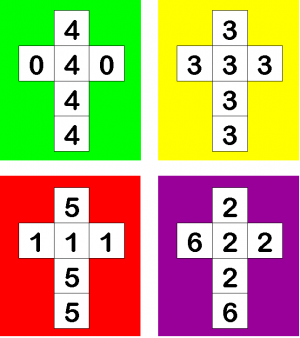GeoGebraSTEM exploration day: Difference between revisions
No edit summary |
TonyHoughton (talk | contribs) No edit summary |
||
| Line 1: | Line 1: | ||
[[Category:Maths]][[Category:Secondary]][[Category:ORBIT]] | |||
{{DISPLAYTITLE:Playing with Probability - Efron's Dice}} | |||
{{Rinfo | {{Rinfo | ||
|title= | |title=Playing with Probability - Efron's Dice | ||
|tagline= | |tagline=I have some dice that are coloured green, yellow, red and purple... | ||
|image= | |image=Nets.png | ||
|topic=Probability | |||
|subject=Maths | |||
|topic= | |resourcenumber= M0021 | ||
|subject= | |age= Secondary, KS3, KS4 | ||
|resourcenumber= | |content= A lesson activity to explore probability with dice | ||
|age= | |strategy= | ||
| | |||
| | |||
|additional resources= | |additional resources= | ||
|useful information= | |useful information= Some large wooden dice that are coloured green, yellow, red and purple with stickers to show numbers (see [[Playing with Probability - Efrons Dice/Activity|this page]]). <br> Any practical probability starting point carries the risk that the results will not, in the short term, produce the expected results. This is a useful discussion point. | ||
|Learning Objectives= By the end of the lesson pupils should be able to: | |||
* see the worth of probability tables and know how to use them to solve a problem | |||
|related resources= | |related resources= | ||
|other= | |other= | ||
| | |final=yes | ||
|licence= | |licence= | ||
|format= wiki page with downloadable .doc version | |||
|resources= [[Playing with Probability - Efrons Dice/Activity]] | |||
}} | }} | ||
Revision as of 06:23, 23 September 2012
Lesson idea. A lesson activity to explore probability with dice
Teaching approach. The half-term activity consists of 3 half-day workshops interspersed with home-working and on-line collaboration. Each workshop is part tutorial and help in GeoGebra, part development, presentation and feedback on their emerging work. The three half-day sessions become gradually less structured as students become more confident taking the initiative in developing their own work:
An initial GeoGebra tutorial session features ‘real life’ examples such as mathematical modelling(ta) and visualisation(ta) from photographs of patterns and structure in flowers and architecture; exercises such as “math aerobics” where students model algebraic functions kinaesthetically; and data analysis and exploration such as from astronomy (Kepler's 3rd law) and athletic performance (Usain Bolt’s 100m sprints). Realistic examples such as these, or from students’ previous work, are essential to get the ball rolling. Following this, the onus is very much on the student’s own initiative. The focus on ‘real life’ and student ownership of ideas and project development increases student motivation.
The activity engages pupils in group talk(ta), mathematical thinking(ta) and vocabulary(ta). This open ended(ta) task develops higher order(ta) reasoning(ta), and encourages whole class(ta) discussion(ta)/questioning(ta) and inquiry(ta) projects. (edit)
| Resource details | |
| Title | Playing with Probability - Efron's Dice |
| Topic | |
| Teaching approach | |
| Learning Objectives | By the end of the lesson pupils should be able to:
|
| Format / structure | wiki page with downloadable .doc version |
| Subject | |
| Age of students / grade | |
| Table of contents | |
| Additional Resources/material needed | |
| Useful information | Some large wooden dice that are coloured green, yellow, red and purple with stickers to show numbers (see this page). |
| Related ORBIT Wiki Resources | |
| Other (e.g. time frame) | |
| Files and resources to view and download | |
| Acknowledgement | |
| License | |

